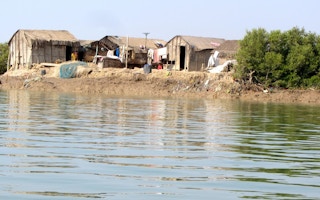The rate at which the global oceans have risen in the past two decades is more significant than previously recognised, say US-based scientists.
Their reassessment of tide gauge data from 1900-1990 found that the world’s seas went up more slowly than earlier estimates - by about 1.2mm per year.
But this makes the 3mm per year tracked by satellites since 1990 a much bigger trend change as a consequence.
It could mean some projections for future rises having to be revisited.
“Our estimates from 1993 to 2010 agree with [the prior] estimates from modern tide gauges and satellite altimetry, within the bounds of uncertainty. But that means that the acceleration into the last two decades is far worse than previously thought,” said Dr Carling Hay from Harvard University in Cambridge, Massachusetts.
“This new acceleration is about 25 per cent higher than previous estimates,” she told BBC News.
Dr Hay and colleagues report their re-analysis in this week’s edition of the journal Nature.
Tide gauges have been in operation in some places for hundreds of years, but pulling their data into a coherent narrative of worldwide sea-level change is fiendishly difficult.
Historically, their deployment has been sparse, predominantly at mid-latitudes in the Northern Hemisphere, and only at coastal sites. In other words, the instrument record is extremely patchy.
What is more, the data needs careful handling because it hides all kinds of “contamination”.
Scientists must account for effects that mask the true signal - such as tectonic movements that might force the local land upwards - and those that exaggerate it - such as groundwater extraction, which will make the land dip.
Attention needs to be paid also to natural oscillations in ocean behaviour, which can make waters rise and fall on decadal timescales.
Previous efforts to untangle the record concluded that sea levels rose through much of the last century by around 1.6-1.9mm per year.
These figures were included in the most recent Intergovernmental Panel on Climate Change (IPCC) report on the state of the planet.
But these numbers have been somewhat problematic because they are at odds with the calculated contributions to global ocean rise - namely, the volumes of water coming from melting land ice, the expansion of the seas from global warming, and changes in the amount of global water held on the continents. Simply put, the calculated contributions were about 0.5mm per year short of what previous tide-gauge assessments were suggesting they should be.
Dr Hay’s and colleagues’ study makes another attempt to sort through the instrument record, and they find the 1900-1990 rises to have been overstated.
Their rate for this period is 1.2mm per year, which neatly closes the contributions “budget gap”.
Dr Hay said: “What we have done, which is a bit different from past studies, is use physical models and statistical models to try to look for underlying patterns in the messy tide gauge data observations.
“Each of the different contributions actually produces a unique pattern, or fingerprint, of sea-level change. And what we try to do is model these underlying patterns and then use our statistical approach to look for the patterns in the tide gauge observations. That allows us to infer global information from the very limited records.”
In the last IPCC report, global mean sea-level rise for 2081−2100 was projected to be between 26cm (at the low end) and 82cm (at the high end), depending on the greenhouse emissions path this century.
If the Hay analysis is reproduced by peer groups, it may prompt the scientific community to revisit these future sea-level projections and some of the other estimates that envisage even larger changes in the decades ahead.
Commenting, Dr Paolo Cipollini at the UK’s National Oceanography Centre, said the Nature study was an important new contribution to the field.
Having a good view of historical change, he explained, would allow researchers to test their models of the processes driving sea-level rise by permitting them to do “hindcasts” - to check whether those models could reproduce the past before making confident projections of the future.
“But let’s not lose sight of the central message that at the moment we have a very strong consensus on the 3.2mm per year of sea-level rise coming from satellites and modern tide gauges, and that any future projection should be based mainly on our understanding of the processes of sea-level rise, which really we need quantify better for later IPCC reports.”
The “gold standard” satellite record of sea-level rise is maintained by the Jason series of spacecraft, which have an unbroken record of measurements stretching back to 1992.
Jason-3, the latest incarnation, launches this year, along with the EU’s Sentinel-3 spacecraft, which has been tasked with starting another continuous - and independent - sequence of observations.










